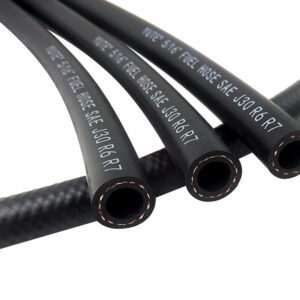Rubber Fuel Hose
When installing the Rubber Fuel Hose joint in the pipeline, it must be installed in a natural state. It is strictly prohibited to deform the joint artificially to adapt to the installation length of the pipeline.
When installing a rubber hose joint, the bolts should be symmetrically and gradually tightened.
The screw of the bolt should extend towards the outer side of the joint, and the bolts connecting the flange on each side should be repeatedly tightened by diagonal compression to prevent pressure deviation. (The threaded joint should be tightened evenly with a wrench, not with a force rod or other means to prevent the joint from slipping and breaking. Regular inspection should be conducted during use to avoid loosening and causing detachment or water seepage.)
After installation, the large diameter rubber hose joint, high pressure rubber, and rubber joints with limit pull rods should adjust the limit nut to the corresponding position based on the elongation and compression of the rubber joint. Allow the rubber joint to freely expand and expand within the designed range of expansion and contraction, without limitation.
The fuel hose supplier reminds that during the installation and use of rubber joints, it is strictly prohibited to remove the limit pull rod without permission, leaving the rubber joint in a completely unprotected state to prevent the actual stretching or compression amount of the rubber joint from exceeding the designed stretching amount, causing damage to the joint such as pulling, tearing, twisting, and squeezing.
When installing rubber hose joints, they should be kept away from heat sources, and strong radiation, exposure to sunlight, and acid alkali corrosion are strictly prohibited.
When used for outdoor installation, a sunshade frame should be built to prevent rain and wind erosion. It is strictly prohibited to paint or wrap insulation materials on the surface of the joint.
When installing rubber joints overhead, corresponding fixed brackets or hangers should be set up to protect the normal operation of the joints; China fuel hose factory recommends that when installing rubber joints underground, a buried protective cover should be installed to ensure that the joints operate normally in their natural state.
Showing all 2 results


